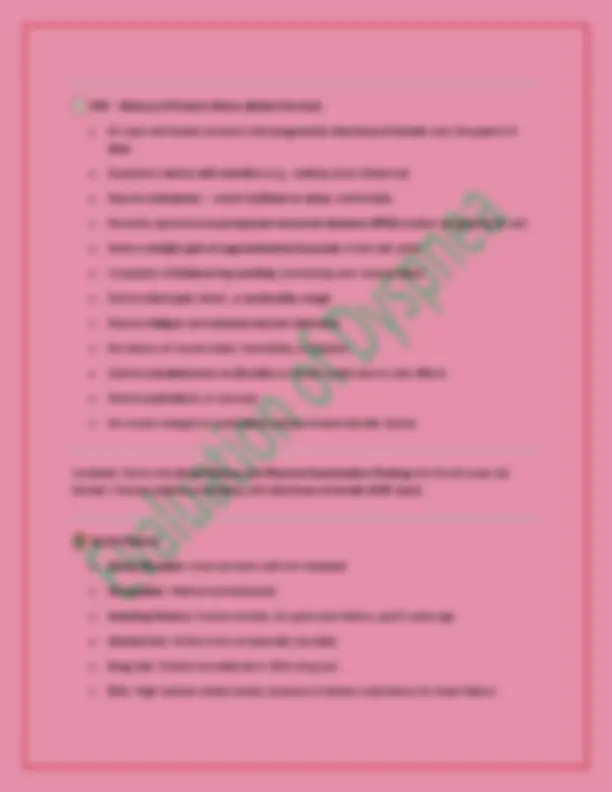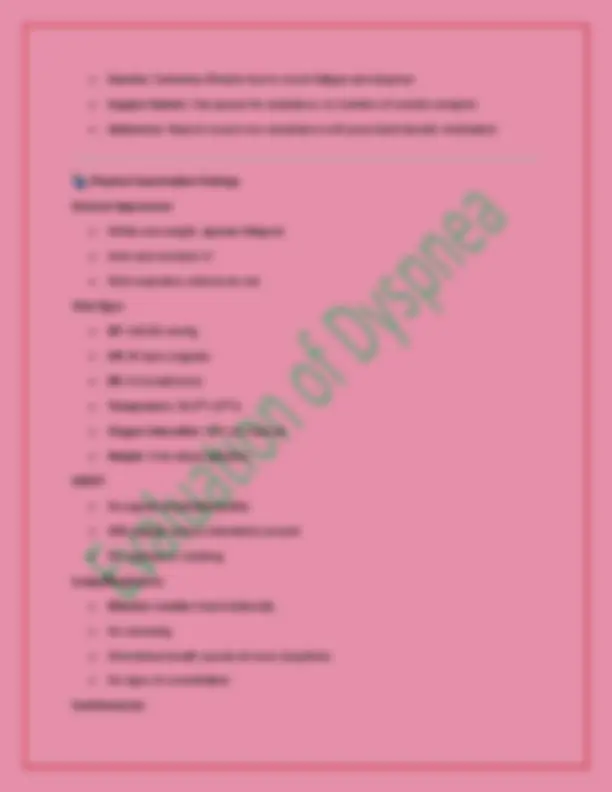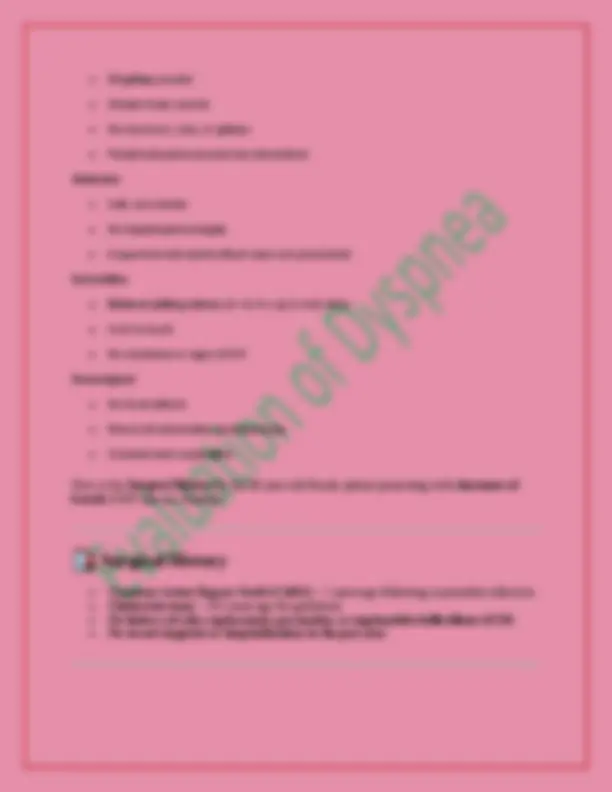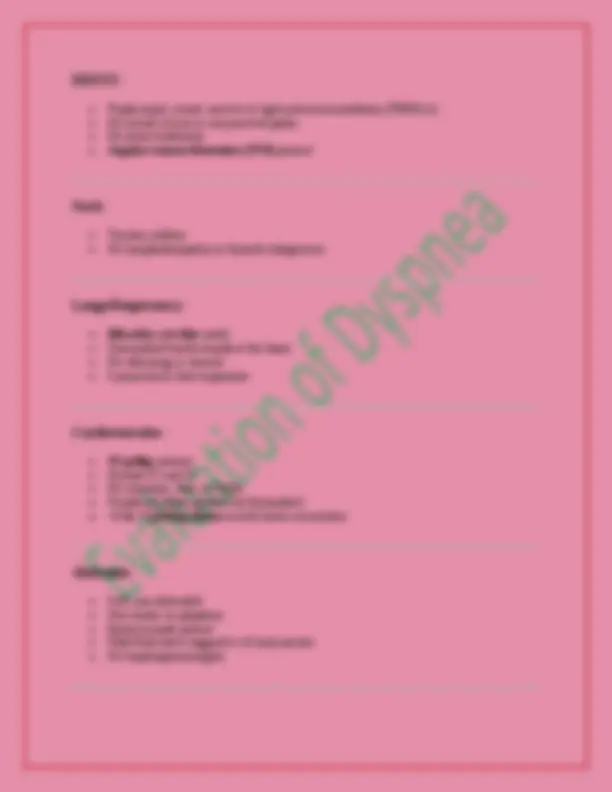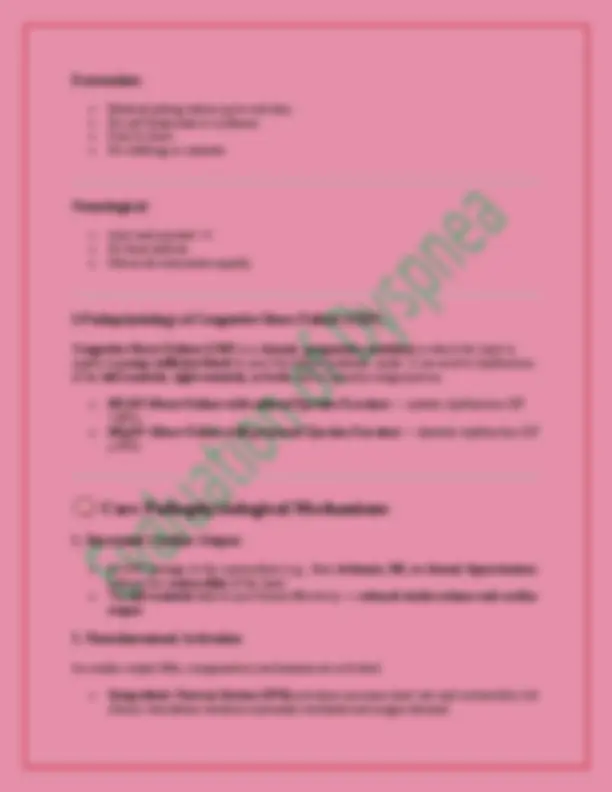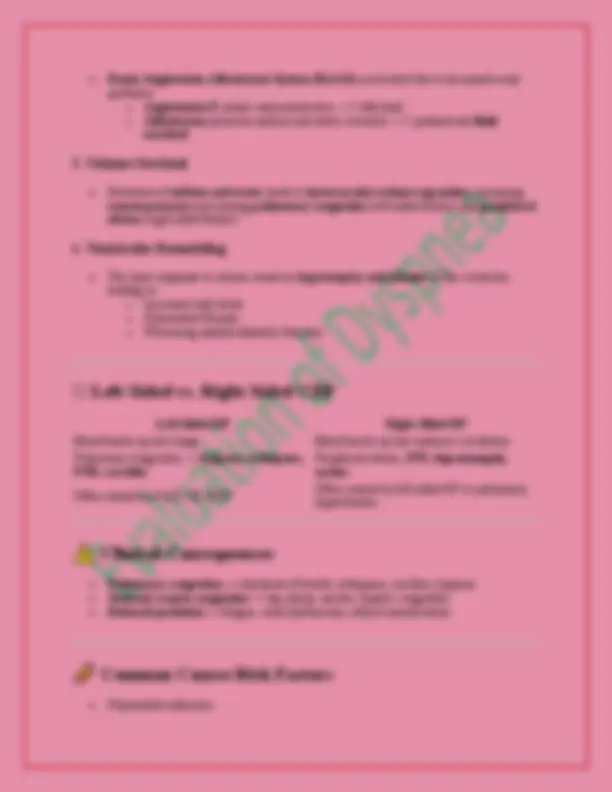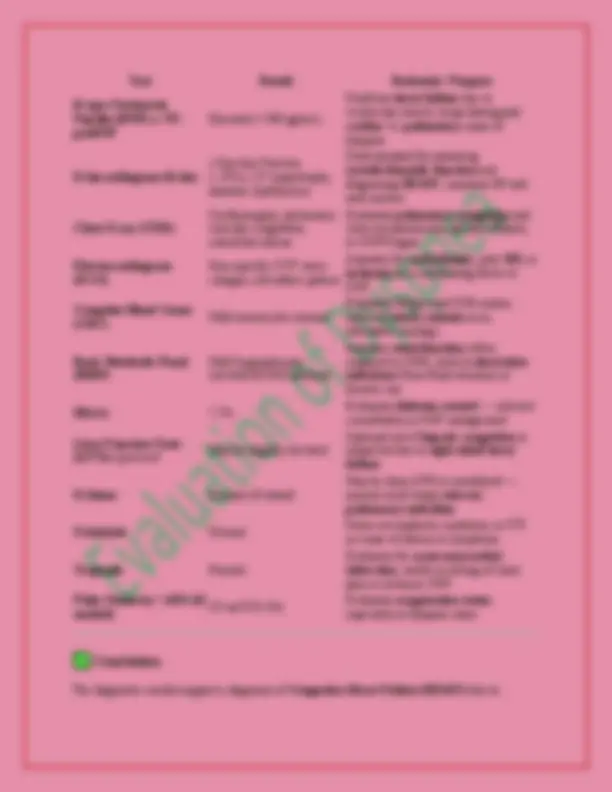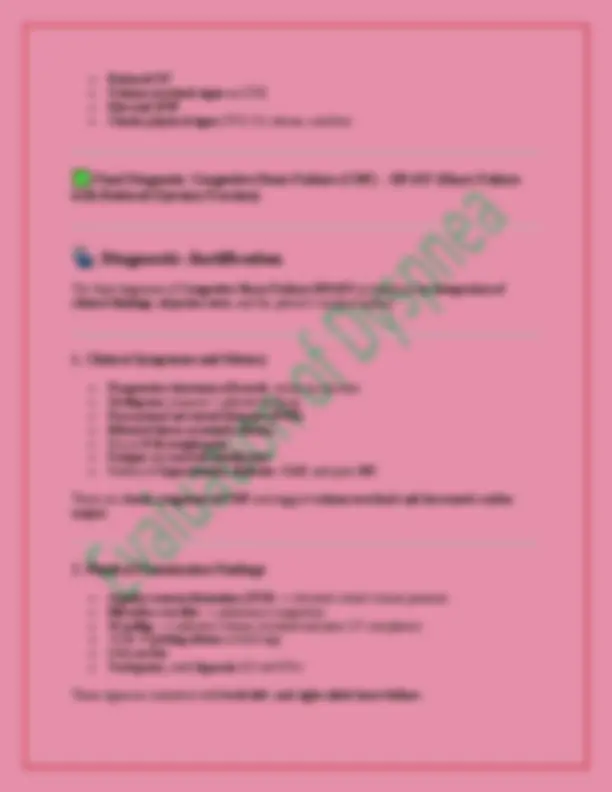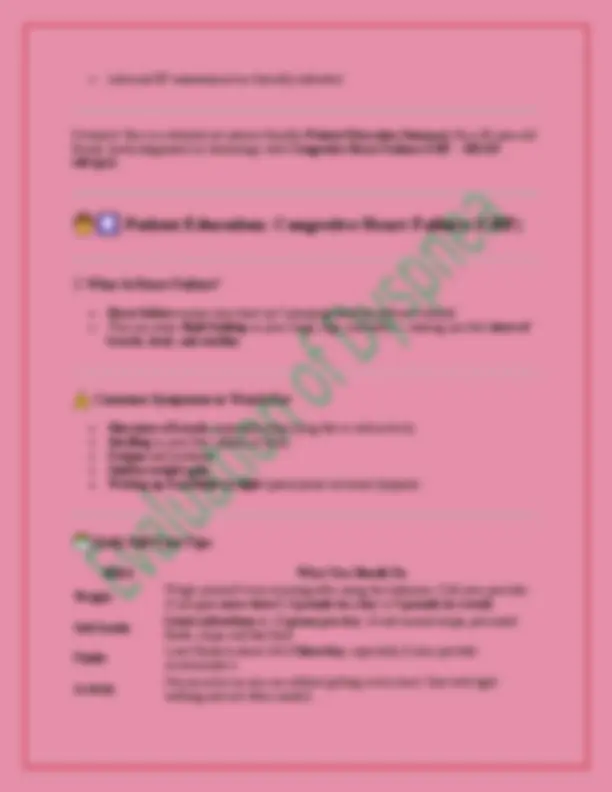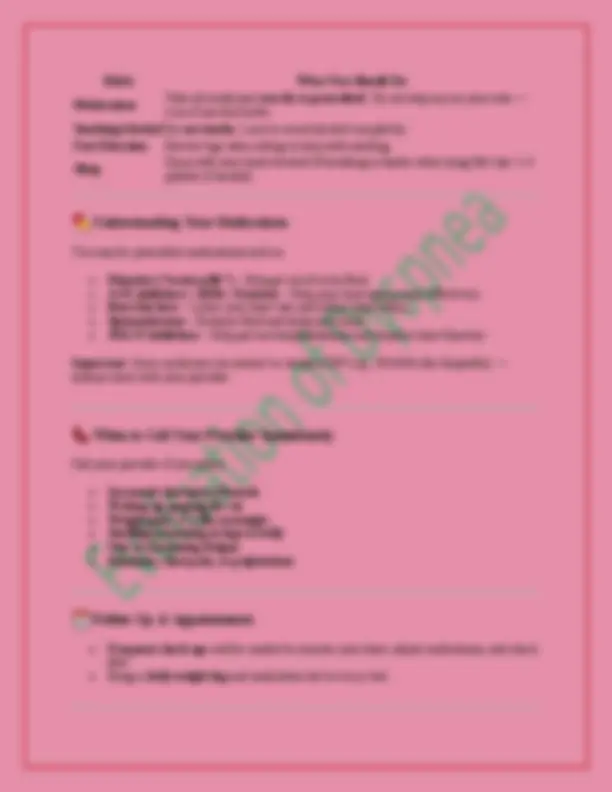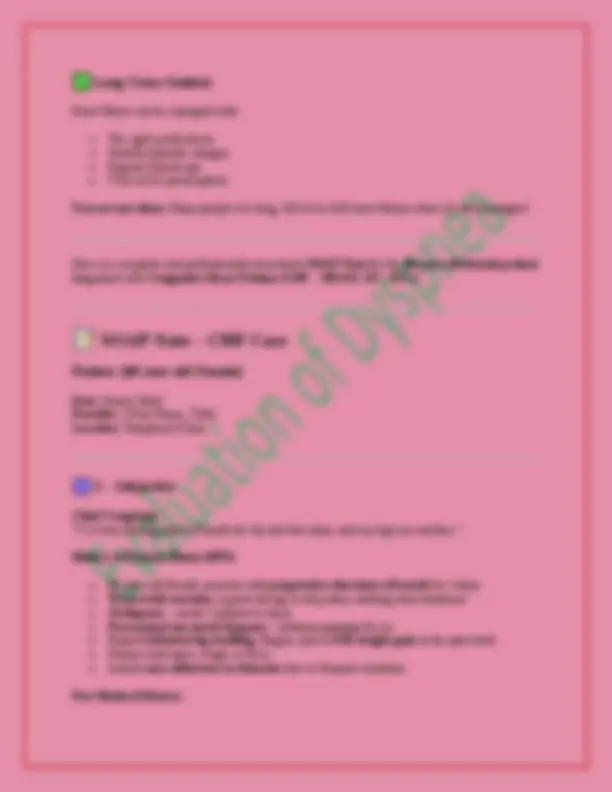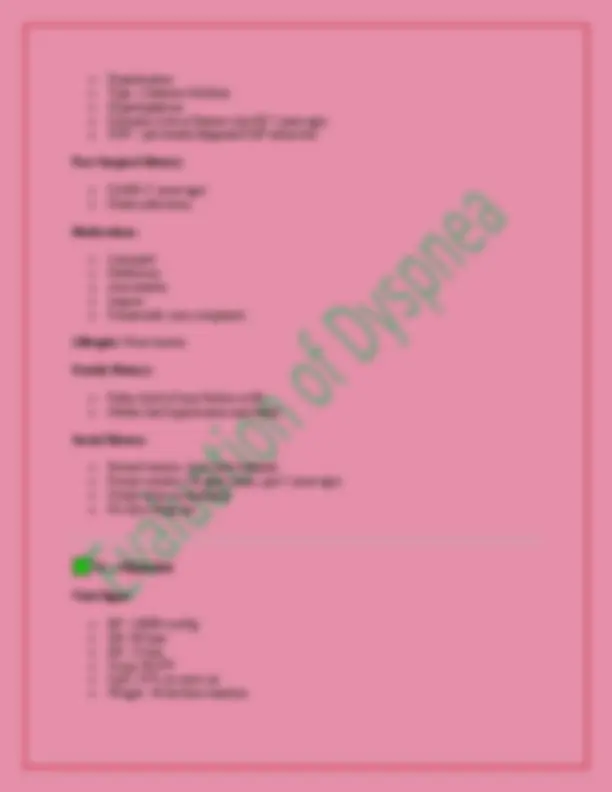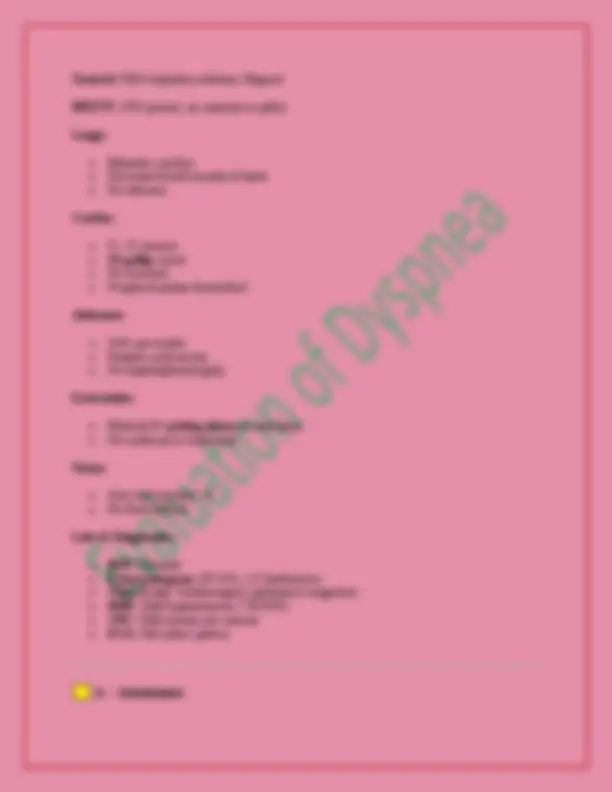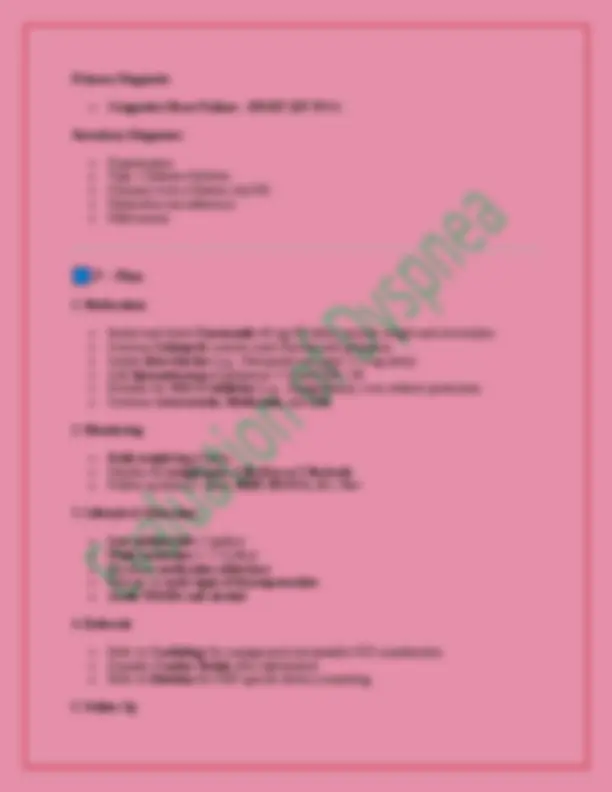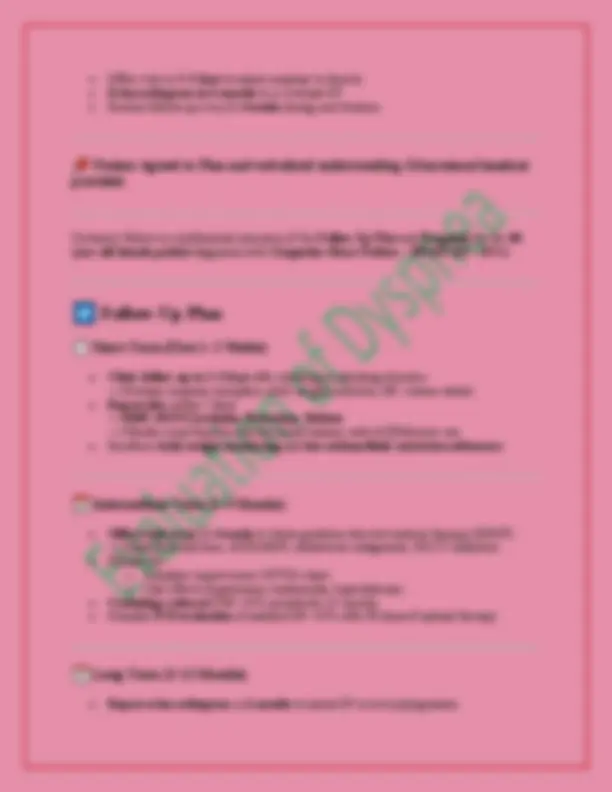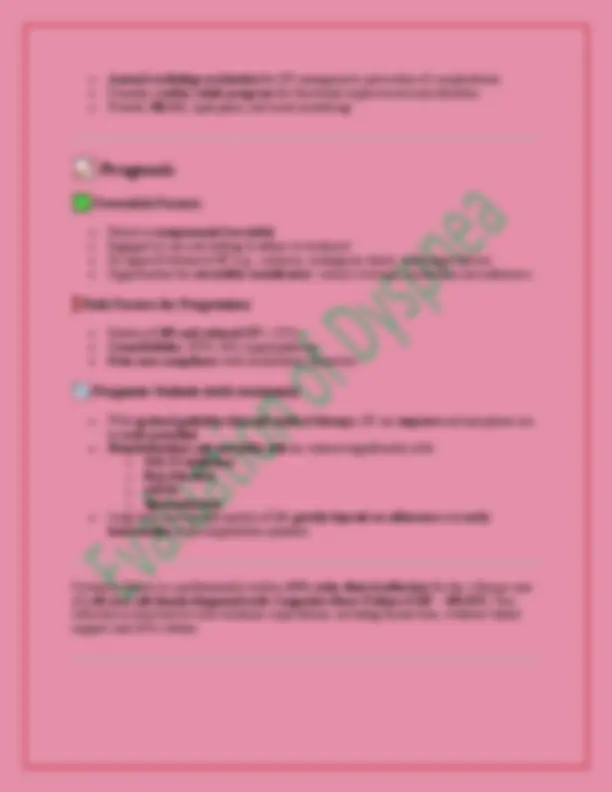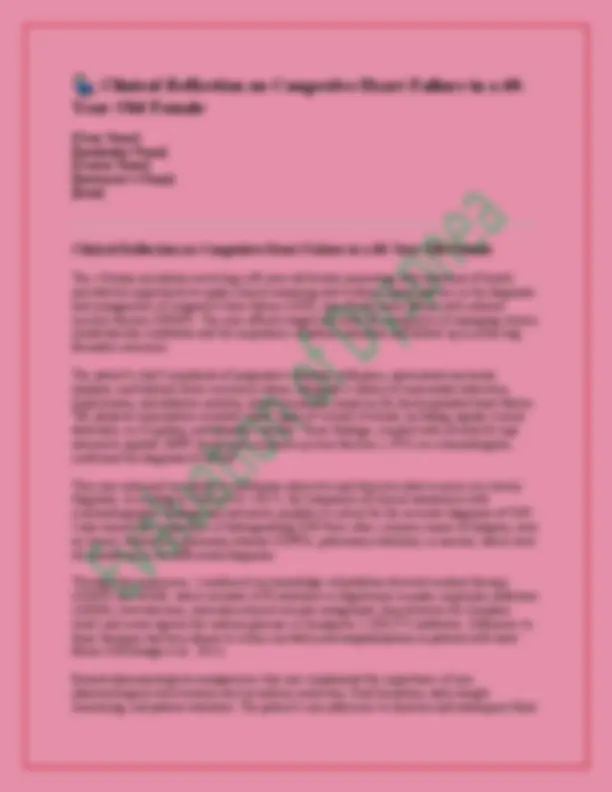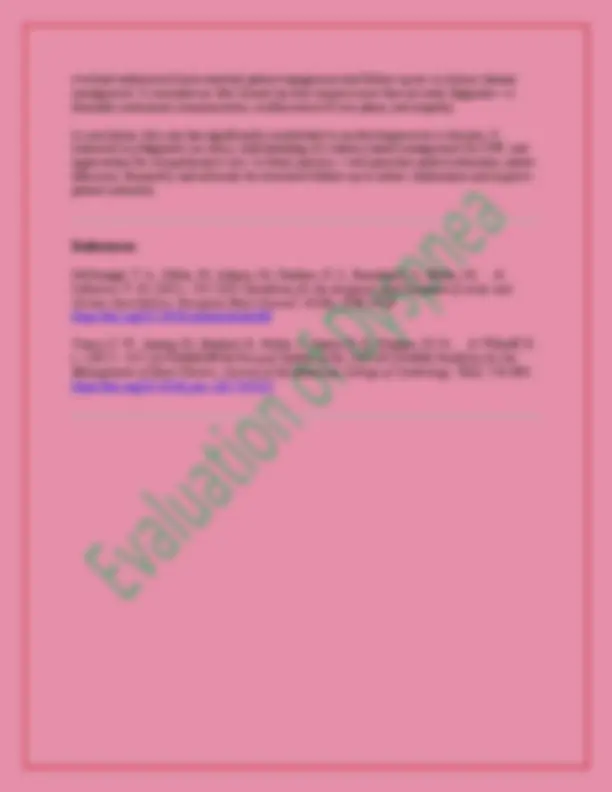Download Week #7 i-Human Case Study: Evaluation of Dyspnea in a 60-Year-Old Female Patient/ ACTUAL and more Exams Integrated Case Studies in PDF only on Docsity!
Week #7 i-Human Case Study: Evaluation of Dyspnea
in a 60-Year-Old Female Patient/ ACTUAL SCREENSHOT
PRESENT 60 YEAR OLD FEMALE PATIENT REASON ;
SHORTNESS OF BREATH (6512 ). WALDEN UNIVERSITY
Comprehensive Case Analysis: CHF Diag
- Exercise : Sedentary lifestyle due to recent fatigue and dyspnea
- Support System : Has spouse for assistance; no mention of outside caregiver
- Adherence : Reports recent non-compliance with prescribed diuretic medication Physical Examination Findings General Appearance
- Mildly overweight, appears fatigued
- Alert and oriented ×
- Mild respiratory distress at rest Vital Signs
- BP : 148/88 mmHg
- HR : 96 bpm (regular)
- RR : 22 breaths/min
- Temperature : 98.6°F (37°C)
- Oxygen Saturation : 92% on room air
- Weight : 8 lbs above baseline HEENT
- No jugular lymphadenopathy
- JVD (jugular venous distention) present
- No cyanosis or clubbing Lungs/Respiratory
- Bibasilar crackles heard bilaterally
- No wheezing
- Diminished breath sounds at lower lung fields
- No signs of consolidation Cardiovascular
- S3 gallop present
- Distant heart sounds
- No murmurs, rubs, or gallops
- Peripheral pulses present but diminished Abdomen
- Soft, non-tender
- No hepatosplenomegaly
- Suspected mild ascites (fluid wave not prominent) Extremities
- Bilateral pitting edema (2+ to 3+) up to mid-shins
- Cool to touch
- No erythema or signs of DVT Neurological
- No focal deficits
- Moves all extremities spontaneously
- Oriented and cooperative Here is the Surgical History for the 60-year-old female patient presenting with shortness of breath (CHF case in i-Human):
Surgical History
- Coronary Artery Bypass Graft (CABG) – 5 years ago following myocardial infarction
- Cholecystectomy – 10+ years ago for gallstones
- No history of valve replacement, pacemaker, or implantable defibrillator (ICD)
- No recent surgeries or hospitalizations in the past year
- Denies dizziness, headaches, or syncope
- No numbness or tingling
Psychiatric:
- Denies depression or anxiety
- Reports feeling “tired all the time”
Endocrine:
- No heat/cold intolerance
- Known Type 2 diabetes
Hematologic/Lymphatic:
- No bruising or bleeding
- No lymphadenopathy
Skin:
- No rash, ulcers, or skin breakdown
- Reports mild shin discoloration (due to edema)
Physical Examination (PE)
Vital Signs:
- BP : 148/88 mmHg
- HR : 96 bpm (regular)
- RR : 22 breaths/min
- Temp : 98.6°F (37°C)
- O2 Sat : 92% on room air
- Weight : +8 lbs from baseline
General:
- Overweight female, alert and oriented ×
- Mild respiratory distress at rest
- Appears fatigued
HEENT:
- Pupils equal, round, reactive to light and accommodation (PERRLA)
- No scleral icterus or conjunctival pallor
- No sinus tenderness
- Jugular venous distention (JVD) present
Neck:
- Trachea midline
- No lymphadenopathy or thyroid enlargement
Lungs/Respiratory:
- Bibasilar crackles noted
- Diminished breath sounds at the bases
- No wheezing or rhonchi
- Symmetrical chest expansion
Cardiovascular:
- S3 gallop present
- Normal S1 and S
- No murmurs, rubs, or thrills
- Peripheral pulses present but diminished
- +2 to +3 pitting edema in both lower extremities
Abdomen:
- Soft, non-distended
- Non-tender to palpation
- Bowel sounds present
- Mild fluid wave suggestive of early ascites
- No hepatosplenomegaly
- Renin-Angiotensin-Aldosterone System (RAAS) is activated due to decreased renal perfusion: o Angiotensin II causes vasoconstriction → ↑ afterload o Aldosterone promotes sodium and water retention → ↑ preload and fluid overload
3. Volume Overload
- Retention of sodium and water leads to intravascular volume expansion , increasing venous pressure and causing pulmonary congestion (left-sided failure) and peripheral edema (right-sided failure).
4. Ventricular Remodeling
- The heart responds to chronic stress by hypertrophy and dilation of the ventricles, leading to: o Increased wall stress o Myocardial fibrosis o Worsening systolic/diastolic function
🫁 Left-Sided vs. Right-Sided CHF
Left-Sided HF Right-Sided HF Blood backs up into lungs Blood backs up into systemic circulation Pulmonary congestion → dyspnea, orthopnea, PND, crackles Peripheral edema, JVD, hepatomegaly, ascites Often caused by CAD, MI, HTN Often caused by left-sided HF or pulmonary hypertension
Clinical Consequences
- Pulmonary congestion → shortness of breath, orthopnea, crackles, hypoxia
- Systemic venous congestion → leg edema, ascites, hepatic congestion
- Reduced perfusion → fatigue, renal dysfunction, altered mental status
Common Causes/Risk Factors
- Longstanding hypertension
- Diabetes mellitus
- Valvular heart disease
- Cardiomyopathies
- Arrhythmias (e.g., atrial fibrillation)
Key Biomarkers & Findings
- BNP/NT-proBNP : Elevated due to myocardial wall stretch
- Echocardiogram : Shows reduced EF (in HFrEF), ventricular size, wall motion abnormalities
- Chest X-ray : Cardiomegaly, pulmonary congestion
- Labs : May show hyponatremia, elevated BUN/Cr (due to hypoperfusion)
Summary Diagram (Text Format)
↓ Myocardial Function (↓ contractility or compliance) ↓ ↓ Cardiac Output → Compensatory Mechanisms: ↑ SNS, ↑ RAAS, ↑ ADH → Vasoconstriction, Fluid Retention ↓ Volume Overload + ↑ Afterload → Pulmonary & Systemic Congestion ↓ Symptoms: SOB, Fatigue, Edema, Weight Gain Here is a detailed Differential Diagnosis Table for a 60 - year-old female presenting with shortness of breath — with CHF as the final diagnosis.
Differential Diagnosis Table: Evaluation of Dyspnea
Diagnosis Supporting Findings Ruling Out/Distinguishing Features Congestive Heart Failure (CHF)
- Dyspnea on exertion- Orthopnea, PND- Bilateral lower extremity edema- Crackles on lung exam- Elevated BNP- S3 heart sound- Echocardiogram: ↓ EF, wall motion abnormalities
- Confirmed by echo- Consistent physical findings and risk history (HTN, CAD, MI)
Test Result Rationale / Purpose B-type Natriuretic Peptide (BNP) or NT- proBNP Elevated (>500 pg/mL) Confirms heart failure due to ventricular stretch; helps distinguish cardiac vs. pulmonary cause of dyspnea Echocardiogram (Echo) ↓ Ejection Fraction (~35%), LV hypertrophy, diastolic dysfunction Gold standard for assessing systolic/diastolic function and diagnosing HFrEF ; measures EF and wall motion Chest X-ray (CXR) Cardiomegaly, pulmonary vascular congestion, interstitial edema Evaluates pulmonary congestion and rules out pneumonia, pleural effusion, or COPD signs Electrocardiogram (ECG) Non-specific ST/T wave changes; old infarct pattern Assesses for arrhythmias , prior MI , or ischemia as a contributing factor to CHF Complete Blood Count (CBC) Mild normocytic anemia Evaluates fatigue and SOB causes; rules out severe anemia as an alternative etiology Basic Metabolic Panel (BMP) Mild hyponatremia, elevated BUN/Creatinine Assesses renal function (often impaired in CHF), detects electrolyte imbalance from fluid retention or diuretic use HbA1c 7.2% Evaluates diabetes control — relevant comorbidity in CHF management Liver Function Tests (LFTs) (optional) May be slightly elevated Optional test if hepatic congestion is suspected due to right-sided heart failure D-dimer Normal (if tested) May be done if PE is considered — normal result helps rule out pulmonary embolism Urinalysis Normal Rules out nephrotic syndrome or UTI as cause of edema or symptoms Troponin Normal Evaluates for acute myocardial infarction ; useful in setting of chest pain or ischemic CHF Pulse Oximetry / ABG (if needed) O2 sat 92% RA Evaluates oxygenation status , especially in dyspnea cases
Conclusion:
The diagnostic results support a diagnosis of Congestive Heart Failure (HFrEF) due to:
- Reduced EF
- Volume overload signs on CXR
- Elevated BNP
- Classic physical signs (JVD, S3, edema, crackles)
Final Diagnosis: Congestive Heart Failure (CHF) – HFrEF (Heart Failure
with Reduced Ejection Fraction)
Diagnostic Justification
The final diagnosis of Congestive Heart Failure (HFrEF) is based on the integration of clinical findings , objective tests , and the patient’s medical history:
1. Clinical Symptoms and History
- Progressive shortness of breath , worse on exertion
- Orthopnea (requires 2 pillows to sleep)
- Paroxysmal nocturnal dyspnea (PND)
- Bilateral lower extremity edema
- Recent 8 - lb weight gain
- Fatigue and exercise intolerance
- History of hypertension , diabetes , CAD , and prior MI These are classic symptoms of CHF and suggest volume overload and decreased cardiac output.
2. Physical Examination Findings
- Jugular venous distention (JVD) → elevated central venous pressure
- Bibasilar crackles → pulmonary congestion
- S3 gallop → indicates volume overload and poor LV compliance
- +2 to +3 pitting edema in both legs
- Mild ascites
- Tachypnea , mild hypoxia (O2 sat 92%) These signs are consistent with both left- and right-sided heart failure.
Comprehensive Management Plan for CHF (HFrEF)
1. Diagnostic Monitoring & Follow-Up
Action Purpose Repeat Echocardiogram in 6–12 months Monitor EF progression or improvement with therapy Monitor BNP/NT-proBNP Assess treatment response and fluid status Daily weight tracking Detect early fluid retention Lab monitoring every 2–4 weeks initially : BMP, BUN/Cr, K+, Na+, HbA1c Monitor renal function, electrolytes, and diabetes control Annual ECG or Holter if arrhythmia suspected Screen for ventricular arrhythmias or atrial fibrillation Consider Stress Test / Cardiac Cath Evaluate for ischemia if symptoms suggest ongoing CAD
2. Pharmacologic Therapy (Goal: Improve Symptoms, Reduce Mortality)
Medication Class & Purpose Plan ACE inhibitor (e.g., Lisinopril) OR ARNI (e.g., Entresto) ↓ afterload, ↓ remodeling, mortality benefit Continue/transition if tolerated (monitor K+/Cr) Beta-blocker (e.g., Metoprolol succinate, Carvedilol) ↓ HR, ↓ mortality, ↑ EF Initiate or uptitrate slowly if stable Loop Diuretic (e.g., Furosemide) Symptom relief, ↓ fluid overload Reinforce adherence, monitor for hypokalemia Mineralocorticoid Receptor Antagonist (e.g., Spironolactone) Mortality benefit in EF <35% Start if renal function and K+ permit SGLT2 Inhibitor (e.g., Dapagliflozin, Empagliflozin) ↓ HF hospitalizations & mortality Consider regardless of diabetes status Statin (e.g., Atorvastatin) Lipid control, secondary CAD prevention Continue as per CAD history ASA or antiplatelet CAD prevention Continue if no contraindications Avoid NSAIDs Can worsen fluid retention Educate patient accordingly
3. Non-Pharmacologic Management
Lifestyle & Education
- Low-sodium diet (<2g/day)
- Fluid restriction (1.5–2L/day, especially if hyponatremic)
- Daily weight monitoring : Alert provider if gain >2–3 lbs/day or 5 lbs/week
- Avoid alcohol and smoking
- Medication adherence education: emphasize importance of diuretics, ACEI, etc.
- Educate on early signs of decompensation : increased SOB, swelling, weight gain Exercise & Cardiac Rehab
- Refer to cardiac rehabilitation for supervised exercise and education
- Light aerobic activity as tolerated (e.g., walking, cycling)
- Avoid isometric heavy lifting or exertion in acute stages
4. Specialist Referrals
Specialist Reason Cardiologist Initiate/monitor guideline-directed therapy, titrate meds Heart Failure Clinic (if available) Intensive monitoring, medication optimization Dietitian Sodium and fluid restriction counseling Endocrinologist (if uncontrolled DM) Optimize HbA1c in the setting of CHF
5. Long-Term Planning & Considerations
Action Indication ICD (Implantable Cardioverter- Defibrillator) If EF remains <35% after 3 months of optimal therapy CRT (Cardiac Resynchronization Therapy) If QRS >150 ms and LBBB pattern Palliative Care (if advanced) Symptom control, quality of life focus Advance Care Planning Discuss prognosis, code status, and end-of-life preferences early in chronic disease course
Follow-Up Schedule
- Initial follow-up : 3–5 days after initiating or changing diuretics
- Every 1–2 weeks during medication titration
- Every 3 months once stable
Habit What You Should Do Medications Take all medicines exactly as prescribed. Do not stop any on your own — even if you feel better. Smoking/Alcohol Do not smoke. Limit or avoid alcohol completely. Feet Elevation Elevate legs when sitting to help with swelling. Sleep Sleep with your head elevated if breathing is harder when lying flat (use 2– 3 pillows if needed).
Understanding Your Medications
You may be prescribed medications such as:
- Diuretics ("water pills") – Help get rid of extra fluid
- ACE inhibitors / ARBs / Entresto – Help your heart pump more effectively
- Beta-blockers – Lower your heart rate and reduce heart strain
- Spironolactone – Reduces fluid and helps your heart
- SGLT2 inhibitors – Help prevent hospitalizations and improve heart function Important : Some medicines can interact or worsen CHF (e.g., NSAIDs like ibuprofen) — always check with your provider.
When to Call Your Provider Immediately
Call your provider if you notice:
- Increased shortness of breath
- Waking up gasping for air
- Weight gain >2–3 lbs overnight
- Swelling worsening in legs or belly
- New or worsening fatigue
- Dizziness, chest pain, or palpitations
Follow-Up & Appointments
- Frequent check-ups will be needed to monitor your heart, adjust medications, and check labs.
- Bring a daily weight log and medication list to every visit.
Long-Term Outlook
Heart failure can be managed with:
- The right medications
- Healthy lifestyle changes
- Regular follow-ups
- Your active participation You are not alone. Many people live long, full lives with heart failure when it's well managed. Here is a complete and professionally structured SOAP Note for the 60 - year-old female patient diagnosed with Congestive Heart Failure (CHF – HFrEF, EF ~35%).
SOAP Note – CHF Case
Patient: [60-year-old Female]
Date : [Insert Date] Provider : [Your Name, Title] Location : Outpatient Clinic
S – Subjective
Chief Complaint : “I’ve been feeling short of breath for the last few days, and my legs are swollen.” History of Present Illness (HPI):
- 60 - year-old female presents with progressive shortness of breath for 4 days
- Worse with exertion ; reports having to stop when walking short distances
- Orthopnea – needs 2 pillows to sleep
- Paroxysmal nocturnal dyspnea – awakens gasping for air
- Reports bilateral leg swelling , fatigue, and an 8 - lb weight gain in the past week
- Denies chest pain, cough, or fever
- Admits non-adherence to diuretics due to frequent urination Past Medical History:

